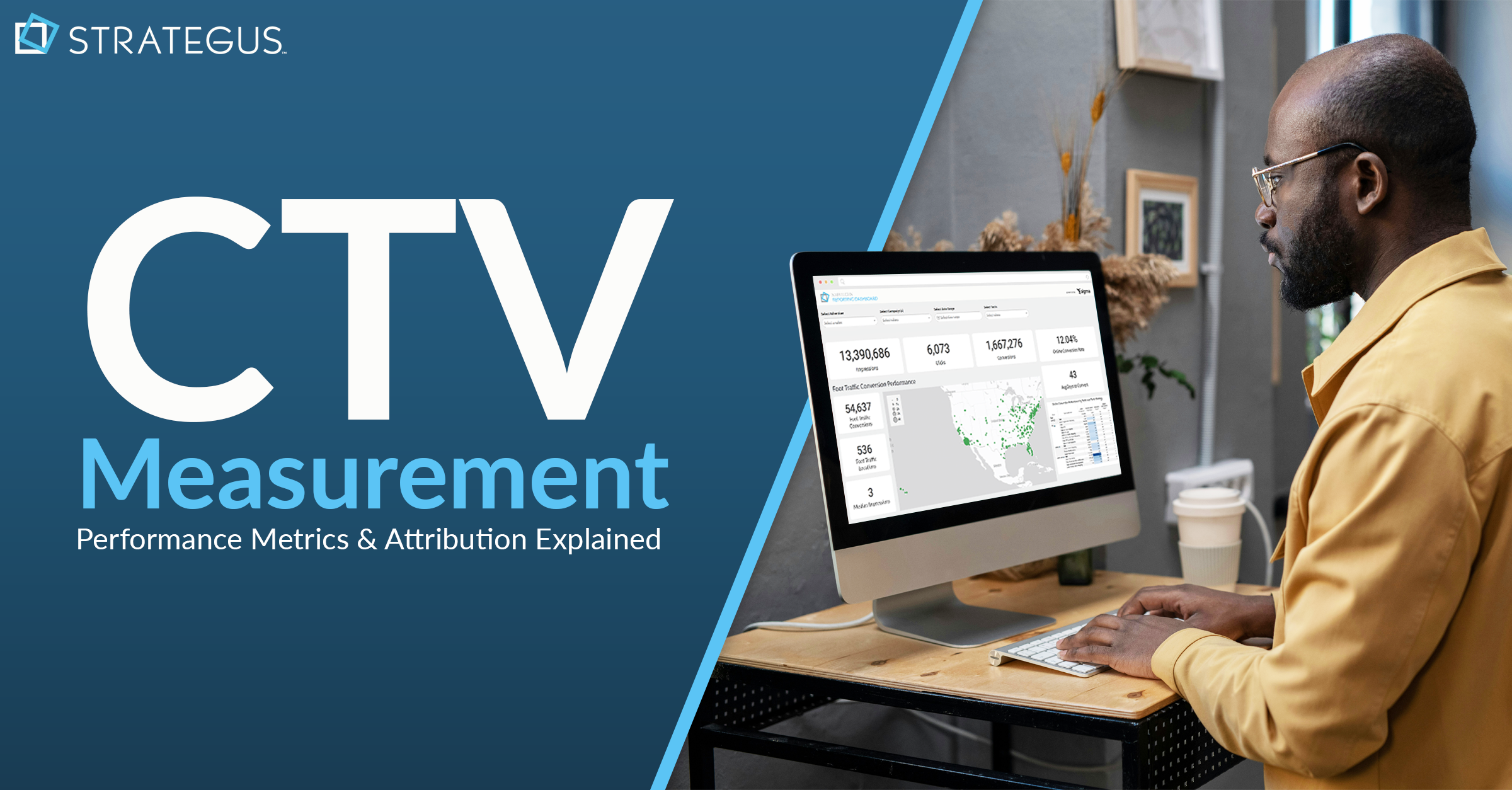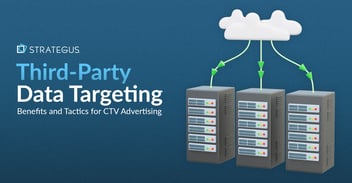- Home
- Strategus Blog
- CTV Measurement: Performance Metrics & Attribution Explained
CTV Measurement: Performance Metrics & Attribution Explained
 Traci Ruether
Traci Ruether
10 minutes read

One of the biggest differences between traditional TV advertising and delivering ads to connected TV (CTV) devices is that the latter can be measured with precision.
When running CTV ads, marketers gain insight into things like:
- How different audience segments respond to an ad.
- What the return on ad spend (ROAS) is for each campaign.
- How the same ad performs across different channels and geographic regions.
- And more.

CTV measurement starts with monitoring basic metrics like impressions and video completion rates (VCR). Insight into these numbers ensures a campaign is active and reaching the right reach and frequency benchmarks.
While these metrics are crucial, they’re only the tip of the iceberg. When CTV campaigns include retargeting tactics and multi-touch attribution tools, it becomes possible to also measure real-world business outcomes — like website visits, online purchases, and even foot traffic — that resulted from a streaming TV ad.
What’s more, with the right reporting and analytics, it’s often possible to compare performance across different audience segments, tactics, creative elements, and more. This allows agencies and brands running CTV campaigns to continuously tweak in-flight campaigns to drive better results.
Keep reading to learn all about the CTV measurement in its many forms, and why it’s such a vital part of ensuring campaign success.
Standard Performance Metrics to Track
The digital nature of streaming TV allows it to deliver more than just content, but also data. Impressions, completions, conversions, and clicks can all be tracked in this internet-connected environment.
Monitoring these is essential for several reasons. For one, keeping an eye on this data ensures brand safety and viewability. It also helps advertisers gain insight into audience engagement and identify opportunities for improvement.
Here’s a look at the most common CTV KPIs and how they might inform your approach.
- Impressions: This metric tells you how many people saw at least a portion of your CTV ad. Although it’s more of a vanity metric in that it doesn’t quantify revenue, it still sheds light on the reach of a given campaign.
- Completion rate: The video completion rate is often high in CTV advertising because the ads are non-skippable and play within user-selected content. For this reason, VCR is more useful for detecting major trends that would indicate an issue, as well as for monitoring completion rates across other streamable channels like online video and streaming audio.
- Clicks: When running omnichannel CTV campaigns that use retargeting tactics across clickable media like search, display, online video, and more, you’ll want to measure how many clicks are generated. This is a straightforward count of the number of times users clicked on your ads to learn more.
- Click-Through Rate (CTR): Click-through rate measures the number of clicks per impression. While the CTR will generally be low, any increase indicates that your efforts are resonating with viewers and driving action. This metric should always be considered in terms of the goal and channel. An awareness ad won’t have a high click-through rate, nor will a CTV ad that lacks clickable elements.
- Conversions: This metric focuses on the specific actions taken by viewers as a direct result of seeing your CTV advertisement. Depending on your campaign, a conversion might mean that the viewer filled out a contact form made an online purchase, or stepped foot into brick-and-mortar locations.
- Conversion Rate: The conversion rate measures the percentage of users who’ve completed a desired action by dividing conversions by impressions. These actions are tied directly to attribution capabilities, which is why we dive deeper into attribution below.
Getting More Granular With Analysis and Reporting
With any digital ad campaign, engagement metrics are important to watch. But to move from passive campaign monitoring to proactive analysis and optimization, you’ll want to dive deeper.
How? A good place to start is by examining analytics related to specific variables like audience segments, creative elements, and ad placements.
Here are some of the CTV reporting capabilities that brands and agencies might prioritize to that end:
 Audience Segment: Compare metrics across audience groups to see how your message is resonating with different viewers and where there’s room for improvement. For instance, if a university finds that ads targeting individuals over age 40 aren’t converting well, they may consider adapting the creative to better resonate with that segment.
Audience Segment: Compare metrics across audience groups to see how your message is resonating with different viewers and where there’s room for improvement. For instance, if a university finds that ads targeting individuals over age 40 aren’t converting well, they may consider adapting the creative to better resonate with that segment.
Geoperformance: Analyze campaign performance above across different geographic regions and determine which locations you’d like to invest more budget. Campaign Comparison: Pinpoint areas for improvement and identify high-performing strategies that can be replicated by comparing two slightly differentiated campaigns. For example, a retailer might compare two holiday campaigns to see which one generated more online sales or in-store visits.
Campaign Comparison: Pinpoint areas for improvement and identify high-performing strategies that can be replicated by comparing two slightly differentiated campaigns. For example, a retailer might compare two holiday campaigns to see which one generated more online sales or in-store visits. Device-Level Reporting: Understand which devices your audience is using to view your ads. Device-level reporting allows you to measure ad performance across screens, ensuring that your creative is optimized for different viewing experiences.
Device-Level Reporting: Understand which devices your audience is using to view your ads. Device-level reporting allows you to measure ad performance across screens, ensuring that your creative is optimized for different viewing experiences. Strategy Breakdown: Analyze the effectiveness of different cross-channel tactics, exposure frequencies, and more by examining different strategies. A travel agency, for instance, might discover that retargeting viewers with display ads leads to higher conversion rates than online video and streaming audio, and thus rework their campaign accordingly.
Strategy Breakdown: Analyze the effectiveness of different cross-channel tactics, exposure frequencies, and more by examining different strategies. A travel agency, for instance, might discover that retargeting viewers with display ads leads to higher conversion rates than online video and streaming audio, and thus rework their campaign accordingly. Creative-Level Breakdown: See how subtle variations in ad creative impact performance. Measuring the performance of individual ad variations helps you discover the creative elements that resonate most with your audience. Even small changes like reworking the calls to action (e.g., "Order Now" vs. "Get Started") may drive vastly different results.
Creative-Level Breakdown: See how subtle variations in ad creative impact performance. Measuring the performance of individual ad variations helps you discover the creative elements that resonate most with your audience. Even small changes like reworking the calls to action (e.g., "Order Now" vs. "Get Started") may drive vastly different results.
Painting the Full Picture With
Multi-Touch Attribution
While detailed reporting and analysis offer valuable insights into specific campaign elements and their performance, these approaches to measurement don't always reveal the full picture of how CTV ads contribute to conversions.
After all, connected TV ads rarely convert in real-time. To truly understand the impact of your CTV campaigns, you need to connect the dots between initial ad exposure and eventual conversions. This is where multi-touch attribution comes in.

How CTV Attribution Works
When advertising on traditional TV, your best bet for quantifying campaign success is finding correlations like spikes in web traffic after an ad airs.
The problem with this approach is twofold: For one, it doesn’t account for the lengthy sales cycle that can occur between an initial ad exposure and conversion. It also fails to isolate the impact of each touchpoint along the way, leaving marketers in the dark about opportunities for campaign optimization.
But with CTV, granular attribution is possible — allowing marketers to shine a light on each touchpoint of a campaign and paint a nuanced picture of the path to conversion.
When approaching CTV attribution, it’s important to come up with a plan prior to launch. Specifically, you’ll want to choose which touchpoints need to be measured across the customer journey — which is often unique to your business model and customers.
For instance, while a direct-to-consumer ecommerce brand like Warby Parker might prioritize tracking website visits and online purchases following ad exposure, a brick-and-mortar retailer would instead focus on in-store foot traffic and conversions.
Here’s a look at how marketers can gain insight across these unique paths to purchase when running CTV campaigns.
- Attribution Modeling: A customized attribution model is designed to align with specific business goals and the customer journey. This model analyzes real-time data to understand the contribution of each touchpoint leading to a conversion.
- Ad Delivery: When CTV ads are served, the viewer's IP address is used to create an identity graph, linking various household devices associated with that user, such as laptops, phones, PCs, and tablets. This enables cross-device tracking of the user's journey.
- Online Data Capture: When someone in that household interacts with the brand (visiting the website, making a purchase, etc.), that data is captured for marketing attribution. CRM data, in-house feedback, and pixels all help ensure that relevant touchpoints are tracked.
- Offline Data Capture: In-store visits or purchases, can also be measured using GPS data to measure the number of viewers who visit physical locations after being exposed to an ad or SKU-level purchase data to attribute sales back to a CTV campaign.
- Measurement and Reporting: Insights from attribution analysis can then be used to continuously optimize campaigns. Look for a CTV partner that provides detailed reports on engagement across various audience segments and locations, as well as a real-time reporting dashboard to track metrics like conversion rate and ROAS.
Benefit From the Most Advanced Attribution Suite in CTV
Insight into the entire buyer’s journey is key to quantifying ROI and driving better results.
Strategus EVP and Co-Founder Joel Cox elaborates:

So what’s so special about the Strategus attribution suite? In a sentence: we offer the largest suite of customizable attribution solutions in the industry and it’s continuously growing.
Understand the Impact of Your Ads
- After-Ad Influence: Tie your CTV ads to online research behavior by tracking URLs and keywords used in online searches immediately following ad exposure.
- Brand Lift: Gauge the true impact of your campaign on brand awareness, favorability, and overall perception. Understand how CTV is shifting the needle on key brand metrics.
- Post-View Website Visitation: See how effectively your CTV ads drive traffic to your website. Quantify the number of viewers that explored your online presence after seeing your brand on the big screen.
Connecting Online and Offline Behavior
- Foot Traffic: Use smartphone GPS data to connect the dots between ad views and in-store visits. Measure the real-world impact of your CTV campaigns on foot traffic.
- Online Purchases: See the full path from ad impression to online checkout. Attribute sales directly to your CTV efforts, providing clear ROI insights.
- CPG Sales: Bridge the gap between online ads and offline purchases for consumer packaged goods. Leverage SKU-level purchase data to connect the dots between CTV exposure and in-store sales.
Advanced Attribution for Deeper Insights
- First-Party Data Matching: Integrate your proprietary customer data with our ad exposure files to gain a deeper understanding of how CTV impacts your existing customer base. Measure new customer acquisition and even assign a dollar value to each new customer gained.
- Revenue Pixel: Track revenue with precision. Implement our revenue pixel to capture the exact revenue associated with each online purchase attributed to your CTV campaign.
- Search and Social Impact: Uncover the hidden influence of CTV on other channels. Measure the lift and improvement CTV advertising has on your search and social campaigns, revealing its role in driving conversions across platforms.
See the Full Picture with Strategus’
Comprehensive Reporting

Every business is different. That's why at Strategus, we go beyond just providing data. We combine the industry's top attribution suite and 24/7 reporting dashboard with a personalized strategy designed to achieve your specific goals.
The result? You get maximum return on investment through our team’s ongoing optimizations, a complete picture of your customer journey, and the numbers to back it up.
Contact us today to get a sneak peek of our reporting dashboard and discuss your attribution needs.

Traci Ruether is a content marketing consultant specializing in video tech. With over a decade of experience leading content strategy, she takes a metrics-driven approach to storytelling that drives traffic to her clients' websites. Follow her on LinkedIn or learn more at traciruether.com.
Strategus is a managed services connected TV(CTV) advertising agency with over 60,000+ campaigns delivered. Find out how our experts can extend your team and drive the result that matter most.
Talk to an Expert
Table of Contents
Seeking a Custom CTV Strategy That Delivers?
What to read next

Best SVOD Platforms for Advertisers
The streaming wars have a new battlefront, and this time, it's all about your ad budget. Just a few years ago, SVOD meant "no commercials." Now, it...
12 minutes read

Third-Party Data Targeting for CTV: Benefits & Tactics
Third-party data. It’s a term that’s thrown around, and yet few take the time to detail its pros and cons — much less strategies for using...
7 minutes read

First-Party Data Targeting: Benefits and Tactics for CTV Advertising
First-party data is the information that companies collect directly from their customers rather than through intermediaries. Advertisers use this...
10 minutes read

Foot-Traffic Attribution: Tying Ad Impressions to In-Store Visits
The marketing funnel has changed. Today’s shoppers often begin researching products from the comfort of their homes and don’t set foot into a store...
8 minutes read

















